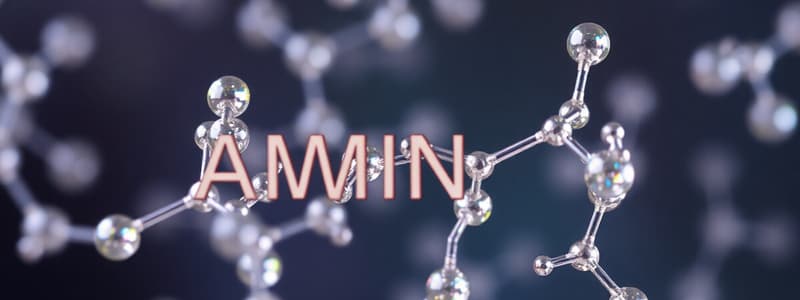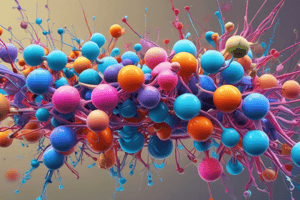Podcast
Questions and Answers
What is the charge of an amino acid backbone at physiological pH?
What is the charge of an amino acid backbone at physiological pH?
- Negative charge
- Positive charge
- Variable charge depending on the side chain
- Neutral charge (correct)
Which group tends to become positively charged when the pH is low?
Which group tends to become positively charged when the pH is low?
- Side chain groups
- Amino groups (correct)
- Carboxyl groups
- Zwitterion groups
Which of the following amino acids is classified as ionizable?
Which of the following amino acids is classified as ionizable?
- Arginine (correct)
- Glycine
- Serine
- Alanine
What effect does increasing the pH have on the carboxyl and amino groups of an amino acid?
What effect does increasing the pH have on the carboxyl and amino groups of an amino acid?
Which statement best describes the ionization state of amino acids at high pH?
Which statement best describes the ionization state of amino acids at high pH?
Which amino acids have the potential to carry a negative charge at physiological pH?
Which amino acids have the potential to carry a negative charge at physiological pH?
What happens to amino acids at low pH?
What happens to amino acids at low pH?
Which of the following options is NOT an ionizable amino acid?
Which of the following options is NOT an ionizable amino acid?
What is the average charge of histidine at its isoelectric point of 7.8?
What is the average charge of histidine at its isoelectric point of 7.8?
What is the predominant ionization state of histidine between the pH values of 6.0 and 9.6?
What is the predominant ionization state of histidine between the pH values of 6.0 and 9.6?
How is the isoelectric point (pI) of an amino acid determined?
How is the isoelectric point (pI) of an amino acid determined?
What happens to the average charge of histidine as the pH decreases?
What happens to the average charge of histidine as the pH decreases?
Which of the following statements about histidine at its isoelectric point is true?
Which of the following statements about histidine at its isoelectric point is true?
What effect does an adjacent negative charge have on a carboxyl group in terms of proton acceptance?
What effect does an adjacent negative charge have on a carboxyl group in terms of proton acceptance?
Which ionizable amino acids are typically positively charged when protonated?
Which ionizable amino acids are typically positively charged when protonated?
When deprotonated, which ionizable amino acids become negatively charged?
When deprotonated, which ionizable amino acids become negatively charged?
Which statement about serine and threonine is true in the context of ionization?
Which statement about serine and threonine is true in the context of ionization?
What largely determines the protonation state of an ionizable amino acid side chain?
What largely determines the protonation state of an ionizable amino acid side chain?
What type of ionizable side chains can be neutral or positive depending on their protonation state?
What type of ionizable side chains can be neutral or positive depending on their protonation state?
Which of the following statements is false regarding the percent ionization of a chemical group?
Which of the following statements is false regarding the percent ionization of a chemical group?
How does an alcohol group behave when placed near a positive charge?
How does an alcohol group behave when placed near a positive charge?
Which amino acids are neutral when protonated?
Which amino acids are neutral when protonated?
What is the primary factor for determining the charge of side chains that contain oxygen or sulfur?
What is the primary factor for determining the charge of side chains that contain oxygen or sulfur?
What occurs to the percentage of deprotonated groups as pH increases?
What occurs to the percentage of deprotonated groups as pH increases?
At what pH is the population of a protonated ionizable group 50%?
At what pH is the population of a protonated ionizable group 50%?
Which statement is true when pH is below the pKa of an ionizable group?
Which statement is true when pH is below the pKa of an ionizable group?
What is the approximate pKa value of the α-carboxyl group in amino acids?
What is the approximate pKa value of the α-carboxyl group in amino acids?
According to the equation pH = pKa + log[A⁻]/[HA], what does [A⁻] represent?
According to the equation pH = pKa + log[A⁻]/[HA], what does [A⁻] represent?
Which side chain has the highest pKa value among the ionizable side chains listed?
Which side chain has the highest pKa value among the ionizable side chains listed?
What happens to the protonation state of an amino acid when the pH is raised above its pKa?
What happens to the protonation state of an amino acid when the pH is raised above its pKa?
What is the pKa value of the histidine side chain?
What is the pKa value of the histidine side chain?
Which factor directly affects the protonation state of an ionizable group?
Which factor directly affects the protonation state of an ionizable group?
What can be concluded when the pH is exactly the same as the pKa?
What can be concluded when the pH is exactly the same as the pKa?
What does the equation $pH = pK_a + log\frac{[A^-]}{[HA]}$ express?
What does the equation $pH = pK_a + log\frac{[A^-]}{[HA]}$ express?
How can the percent ionization of an amino acid be calculated?
How can the percent ionization of an amino acid be calculated?
What does the isoelectric point (pI) of an amino acid represent?
What does the isoelectric point (pI) of an amino acid represent?
At what pH is histidine predominantly positive?
At what pH is histidine predominantly positive?
How does pH impact the net charge of amino acid populations?
How does pH impact the net charge of amino acid populations?
What occurs to histidine molecules at physiological pH?
What occurs to histidine molecules at physiological pH?
To calculate the pI of any amino acid, you average which two values?
To calculate the pI of any amino acid, you average which two values?
In what scenario can a population of amino acids collectively have a net negative charge?
In what scenario can a population of amino acids collectively have a net negative charge?
What is a characteristic of amino acids at low pH?
What is a characteristic of amino acids at low pH?
When examining amino acid ionization, which is an important factor?
When examining amino acid ionization, which is an important factor?
Flashcards
Ionizable Groups
Ionizable Groups
Chemical groups that can gain or lose protons, resulting in a change in charge. These groups are crucial for acid-base reactions and can be either positively charged (cations) or negatively charged (anions).
Amino Acid Acid-Base Chemistry
Amino Acid Acid-Base Chemistry
Amino acids can participate in acid-base reactions by donating or accepting protons (H+). This ability is crucial for their function and depends on the surrounding environment, particularly the pH.
Zwitterion
Zwitterion
A molecule with both a positive and a negative charge, making it electrically neutral overall. This is the typical state of amino acids at physiological pH.
Backbone Ionizable Groups
Backbone Ionizable Groups
Signup and view all the flashcards
Ionizable Side Chains
Ionizable Side Chains
Signup and view all the flashcards
pH Effect on Protonation
pH Effect on Protonation
Signup and view all the flashcards
Acidic Conditions (Low pH)
Acidic Conditions (Low pH)
Signup and view all the flashcards
Basic Conditions (High pH)
Basic Conditions (High pH)
Signup and view all the flashcards
Acidity/Basicity
Acidity/Basicity
Signup and view all the flashcards
Protonated
Protonated
Signup and view all the flashcards
Deprotonated
Deprotonated
Signup and view all the flashcards
Environmental Influence on Acidity/Basicity
Environmental Influence on Acidity/Basicity
Signup and view all the flashcards
pKa
pKa
Signup and view all the flashcards
Nitrogen-Containing Ionizable Amino Acids
Nitrogen-Containing Ionizable Amino Acids
Signup and view all the flashcards
Oxygen/Sulfur-Containing Ionizable Amino Acids
Oxygen/Sulfur-Containing Ionizable Amino Acids
Signup and view all the flashcards
Percent Ionization
Percent Ionization
Signup and view all the flashcards
Protonation/Deprotonation
Protonation/Deprotonation
Signup and view all the flashcards
pH and Protonation
pH and Protonation
Signup and view all the flashcards
Ionizable Groups in Amino Acids
Ionizable Groups in Amino Acids
Signup and view all the flashcards
pKa Values of Amino Acid Backbones
pKa Values of Amino Acid Backbones
Signup and view all the flashcards
pKa Values of Ionizable Side Chains
pKa Values of Ionizable Side Chains
Signup and view all the flashcards
Henderson-Hasselbalch Equation
Henderson-Hasselbalch Equation
Signup and view all the flashcards
Below pKa
Below pKa
Signup and view all the flashcards
Above pKa
Above pKa
Signup and view all the flashcards
Protonation and Protein Function
Protonation and Protein Function
Signup and view all the flashcards
Isoelectric Point (pI)
Isoelectric Point (pI)
Signup and view all the flashcards
Average Charge of an Amino Acid
Average Charge of an Amino Acid
Signup and view all the flashcards
Study Notes
Acid-Base Chemistry of Amino Acids
- Amino acids can exchange protons with their environment
- Protonation/deprotonation affects chemical groups
- Ionizable groups can become positive or negative
- Amino acids have at least two ionizable groups: backbone amino and carboxyl
- Zwitterion: neutral state at physiological pH (protonated amino group, deprotonated carboxyl group, net charge of 0)
- pH adjustments change protonation states
- Lower pH: more protons available, carboxyl and amino groups more likely to be protonated, overall positive charge
- Higher pH: fewer free protons, carboxyl and amino groups more likely to be deprotonated, overall negative charge
Ionizable Amino Acid Side Chains
- Side chains of many amino acids are electrically neutral at physiological pH
- Some side chains can become charged (positive or negative)
- Ionizable amino acids: arginine, lysine, histidine, tyrosine, cysteine, glutamate, aspartate
- Side chain ionization affected by environment
- Negative charge nearby: carboxyl group more likely to accept a proton, becoming more basic
- Positive charge nearby: alcohol more likely to lose a proton, becoming more acidic
Amino Acid Percent Ionization
- Percentage of ionizable groups in a population that are protonated depends on the pKa (the pH at which 50% of the ionizable group is protonated/deprotonated) and the pH of the solution
- Lower pH than pKa: More likely to be protonated
- Higher pH than pKa: More likely to be deprotonated
Isoelectric Points (pI)
- The pH at which an amino acid population has an average net charge of zero (each positive charge balances out a negative charge)
- Calculated by averaging pKa values where amino acid is predominantly positive and negative
- Histidine example: pI = (6.0 + 9.6) / 2 = 7.8
Amino Acid Titration Curves
- Titration: Solution of amino acid brought to a low pH, strong base (NaOH) added gradually, pH plotted against amount of base added
- Reveals identity of unknown amino acids
- Buffer regions: pH ranges around pKa values where the amount of base added does not result in a large change in pH
Studying That Suits You
Use AI to generate personalized quizzes and flashcards to suit your learning preferences.
Related Documents
Description
Explore the intricate acid-base chemistry of amino acids and their protonation states in various pH environments. This quiz covers the characteristics of zwitterions and the ionizable side chains of amino acids, which affect their overall charge. Understand the significance of ionizable groups in biochemical contexts.



